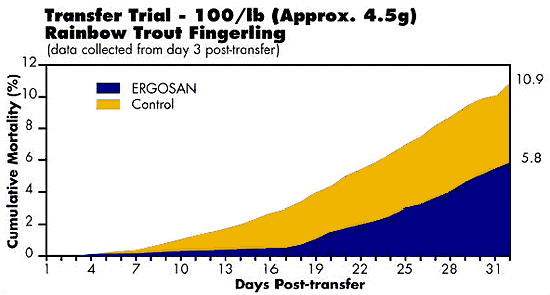Background
Trout Farm A has, for the past couple of years, been selling fingerling
rainbow trout to Trout Farm B. Historically, what has been seen is that
in the period immediately after transport, elevated mortality has been
suffered at Trout Farm B due to RTFS, as a result of the stress on the
fish induced by the transport.
Trout Farm A, like virtually all hatchery sites, has endemic RTFS, which
is treated with disinfection and antibiotic therapy in the normal way.
However, it appears impossible to eliminate the disease entirely, and
even when healthy fish are transported, in the days post-transport,
RTFS outbreaks have occurred in the fish. This is presumably because
there are fish within the population which maintain a carrier status.
In an effort to reduce the impact of the transport on the occurrence of RTFS and
subsequent mortality at Trout Farm B, a trial was conducted using Ergosan, fed to the
fish prior to transport, to see if this would reduce the level of mortality due to RTFS.
Facts
A batch of 60 000 fingerling of 100/lb (approx. 4.5g) size held at Trout Farm A and due for transport to Trout Farm B were divided equally and randomly into 2 identical ponds, 30 000 fish per pond. One pond was fed Ergosan at 0.2% of the daily feed rate (1.5-2% biomass) for a period of 5 days (28th March to 1st April), immediately prior to the fish being starved and transported on 3rd April. The other pond (Controls) was fed normal diet over this period. The fish were then moved to Trout Farm B on 3rd April and placed into 2 similar raceways. Total mortality was recorded on a daily basis over the next 5 weeks and an assessment of the cause of mortality made.Results

This graph shows cumulative mortality in the two raceways from the third day after arrival of the fish on site (6th April) until 5th May. Looking at the control fish (no Ergosan), it can be seen that within a couple of days the mortality in this raceway starts to increase, and continues at a significant level until the end of the trial period, with a total mortality of 10.9%. This mortality was confirmed as a result of RTFS.
By comparison, over this initial period, the mortality in the treated fish (with Ergosan) remains at a very low level and continues at a significantly lower daily mortality rate until 20th April. From this point it then starts to increase and runs at a similar level to the control mortality until the last recording on 5th May. A total mortality of 5.8% was recorded.
This suggests that the Ergosan has had an effect on the level of RTFS in the raceway up until 20th April. Bearing in mind that the Ergosan was fed to the fish at Trout Farm A from 28th March to 1st April, this fits very well with our indications of a period of some 20-25 days elevated immune response as a result of feeding with Ergosan.
A total reduction in mortality of 5.1% in the period of around 4 weeks was realised.
Conclusions
Ergosan treatment prior to transport has reduced the incidence of RTFS within the treated fish. A subsequent lower mortality rate was experienced in the treated fish.Source: Schering-Plough Aquaculture - March 2004


